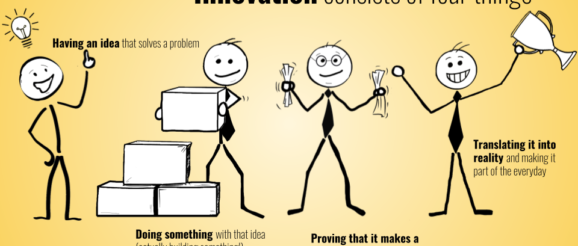How To Avoid Innovation Theatre – Paul Taylor

Consistent investment, dedicated teams, proper evidencing of decisions, alignment with strategy. A simple but critical recipe for innovation in future-ready organisations – Tom Cheesewright
One of the questions I get asked most frequently is“How do you define innovation?”
This week I’ve been asked it several times so here’s a short post to recap my thoughts.
Innovation is executing new ideas to create value. The mistake a lot of people are making at the moment, and hence the overuse of the word, is that they are forgetting two things:
- Creativity is not innovation.
- Continuous improvement is not innovation.
Creativity is a prerequisite for sure. Innovation, however, is the practical application of creativity.
- You can bring someone in to give an “inspirational talk” on innovation
- You can hold a one-day workshop to get your company to be more creative
- You can get a cool space with loads of beanbags and motivational posters
- You can have a hack day
That’s not innovation. That’s what Steve Blank termed innovation theatre. Just for show, with no real outcome.
Innovation theatre can be of value as it can excite people and show them the possibilities. It’s fun, and fun is important. Let’s not confuse it with innovation though.
 Innovation consists of four things:
Innovation consists of four things:
- Having an idea that solves a problem
- Doing something with that idea
- Proving that it delivers new value for people
- Translating it into reality and making it part of the everyday
To be innovative, we need to be good at both idea generation and idea execution.
A new idea is usually rejected or resisted by the prevailing system. Therefore ideas that are new and that could complicate or even threaten the existing way of working means creating space where we can protect them.
It also needs protection from the organisational desire to complete things quickly. All the talk about agility is somewhat misplaced. If you work in innovation or design you’ll always see a time lag from inception to implementation. Even in the best organisations, it will take months, sometimes years, for new concepts to be assimilated into the everyday culture. Many (most) never make it.
That’s why there are always questions about how innovation teams spend their time and whether it’s worthwhile. When you’re working two years into the future it’s really hard to demonstrate outcomes that fit conventional performance frameworks.
Six ways to avoid innovation theatre
- Have a consistent way to define and measure innovation, so that it’s unambiguous in your company
- Look for good problems rather than great ideas
- Periodically assess the areas of your business so that you know where each stands in terms of innovation capability and capacity
- Get senior leaders to identify and sponsor specific initiatives designed to address the key problems
- Assemble smalls teams to work on the challenges. Use disciplined protocols to help these teams succeed.
- Document, and track progress and share progress internally and externally
To be an innovative organisation you need to be great at defining problems, at generating ideas, at selecting and executing them, and at getting them to spread.
Innovation mostly requires a little curiosity and a lot of persistence.
Thanks to Katie Fletcher for the cool graphic
- Category:Innovation
